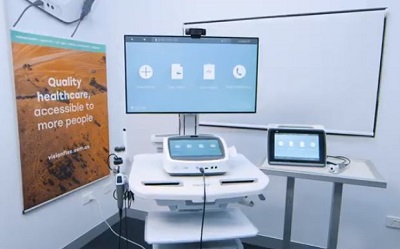Telehealth isn’t telehealth if it is on Zoom – by Mike Harman

Sophisticated medical tests such as heart rate, pulse oximetry and even endoscopy can be carried out by medical practitioners remotely via specialised video links, but despite greater public acceptance, most remote medical consultations still take place via telephone, or at best Zoom. Here Mike Harman outlines the future of remote health – and it is available today.
Remote medicine has been a part of the Australian landscape, ever since the invention of the pedal-powered radio paved the way for the launch of the Royal Flying Doctor Service in 1928.
Now, it’s integral to the delivery of health services across Australia and around the world.
COVID-19 has normalised the use of telehealth, as has increased funding for Medicare telehealth rebates. The health minister has assured us ‘telehealth is here to stay’ and the government is now pushing for telehealth in aged care homes following recommendations from the Royal Commission into Aged Care Quality and Safety.
Financially, we know the telehealth sector’s future looks bright. Industry figures indicate the global telehealth market will grow by 16 per cent (CAGR) 2021-2027, with 2027 market value predicted to exceed USD150B.
In Australia, we anticipate growth will be largely driven by the application of telehealth services in aged care – a sector that is traditionally under resourced and resistant to change and technological advancements.
Business giants like Amazon, Walmart, and Zoom, have moved into the telehealth/digital-health market and are manoeuvring for a piece of the action in the large US market. While in Australia, companies such as Telstra Health, Healthdirect and others are also making noise. As for consumers, there is now an expectation that telehealth services are available, and to not offer a remote service is to risk losing business.
But the continued evolution of telehealth services will depend largely upon one thing: how do we leverage off the current zeitgeist and ensure that telehealth is sustainable beyond the current public health emergency?
Today, around 97 percent of telehealth consultations are still conducted via telephone. When a video consultation is performed, it is often via traditional consumer video conferencing platforms such as Zoom or Teams.
Video conversations with your health provider can be helpful in some situations such as mental health and allied health consultations or perhaps with discussions around patient wellbeing. But generally speaking, a video call is no better than a traditional phone call.
I believe a key factor in telehealth’s future is the expansion of the technology’s clinical repertoire way beyond conducting face-to-face consultations via video conferencing.
A true telehealth consultation should give the remote physician access to all the images and data they would normally have if the patient was with them in the consulting room. Data such as an ECG trace, stethoscope sounds, temperature, blood pressure, blood sugar, pulse oximetry, weight, ultrasound and of course, a range of video examinations such as endoscopy, dental, ophthalmology, otoscopy, dermatology, and wound management.
Having access to this information enables the consulting physician to make an informed diagnosis and to create a treatment plan.
My company Visionflex’s ProEX telehealth system (pictured, below) enables remote, clinical patient examinations, combining HD video-conferencing software and medical devices including ultrasound, stethoscope, endoscope, otoscope, pulse oximeter, ECG, thermometer, blood-pressure monitor, weighing scales and a GEIS General Examination Camera HD.
It delivers medical expertise to the point of need, but it’s important to understand that telehealth is not a replacement for face-to-face consultations. A mix of traditional and telehealth consultations is the way forward.

Mike Harman studied electronic engineering and has worked in the med-tech sector for more than 25 years. Mike is CEO and co-founder of Sydney telehealth hardware and software developer Visionflex.
Picture: Visionflex/Mike Harman, main and ProEX Telehealth Hub, below
Subscribe to our free @AuManufacturing newsletter here.
@aumanufacturing Sections
Analysis and Commentary Awards Defence Manufacturing News Podcast Technology Videos










